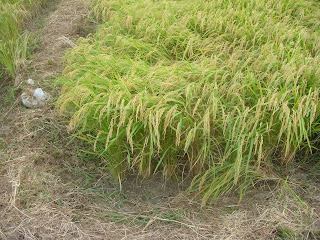I left the riverside and walked north to the main road that runs east from Izumi Chuo. This area still has large rice paddies, so for those of you who do not know what they look like I have included these three pictures. Above is a picture of a whole paddy.
This is what it looks like up closer. During the spring when the rice is first planted, this would be all water but during the later stages of growth the ground is allowed to dry out. This is natural as during the spring time rainy season the low lying areas fill with water and then they dry out during the summer.
This rice is almost ready for harvest. You can see that each plant has many individual grains. In recent years they have been gradually changing the rice so that the yield is greater and the height of the plants is lower, making them stronger and less susceptible to damage for the typhoons that arrive in the fall.
On the north side of the paddies there is a temple. The blue area is a tarp that is stretched over a damaged roof.
In this area the liquification of the ground caused the sewer pipes to rise (the small pieces of dirt and stone went under the pipes pushing them up through the sidewalks). I have no idea how they will repair these. In many places the manhole covers are now as much as a foot (30 cm) above the sidewalk.
I walked over to the temple and discovered that the graveyard was still in disarray. Many of the gravestones had fallen over and were yet to be repaired. I am not sure that this is the specific reason for the delay, but I do know that the necessary cranes to lift the stones back into their proper locations are hard to hire as are the operators. There is so much repair work going on that the all equipment and personnel are in short supply.
Subscribe to:
Post Comments (Atom)







No comments:
Post a Comment